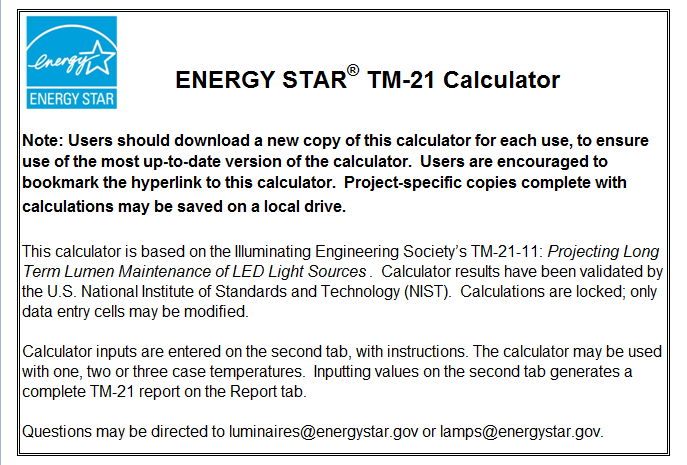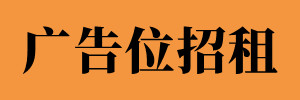|
|
Q:有没有哪位有能源之星TM21报告啊,任何芯片的,能不能发一份给我啊) h0 ]5 i3 u4 H+ j" j6 M6 a
A:请查看,能源之星TM21报告。1.Rev.020712
/ M; \5 Q1 O: C2 CENERGY STAR® TM-21 Calculator ; c! k" } v) A/ h2 l7 h
Note: Users should download a new copy of this calculator for each use, to ensure use of the most up-to-date version of the calculator. Users are encouraged to bookmark the hyperlink to this calculator. Project-specific copies complete with calculations may be saved on a local drive.. s0 G/ l) y# |8 V9 S: X
$ P' x+ W4 ~1 h4 P$ m) _2 O- IThis calculator is based on the Illuminating Engineering Society’s TM-21-11: Projecting Long Term Lumen Maintenance of LED Light Sources. Calculator results have been validated by the U.S. National Institute of Standards and Technology (NIST). Calculations are locked; only data entry cells may be modified.! W' s3 s2 x2 p7 k
0 d2 S* k& |0 ?" j+ M8 j: o+ c6 Z
Calculator inputs are entered on the second tab, with instructions. The calculator may be used with one, two or three case temperatures. Inputting values on the second tab generates a complete TM-21 report on the Report tab.
5 q: ~+ A: m8 i
4 u, X$ B. \$ s. E9 F6 rQuestions may be directed to luminaires@energystar.gov or lamps@energystar.gov.6 D( ^ \. U5 P
& V+ I P4 r: O! o' q* U/ P

. }2 F" V4 B7 z2.TM-21 Inputs) e4 c# E. t: R6 N( i
LM-80 Test Inputs
, b2 R& Q% k# n4 i; U2 p9 p: sInstructions
u, T, n7 L2 i( OYellow fields are completed by the user. Fields not used should be left blank. Cyan fields are calculated based on user entries.6 c) x$ g5 n4 L7 V x7 I
' Z2 i' [5 L4 ~1 G* _First, enter a description of the LED light source tested. Then complete the fields labeled "LM-80 Testing Details". Test duration must be at least 6,000 hours. If only one case temperature data set is to be used (no interpolation), complete only "Tested case temperature 1". For only two case temperature data sets, complete 1 and 2.
" X* J1 `5 S \& E7 E' Z0 ^& W3 n0 N+ ?. g( Y
Next, further to the right, in the corresponding box(es) for each tested case temperature, enter the test data along with the time (in hours) at which each measurement was taken. Data entered must be normalized then averaged measured data (per TM-21 sections 5.2.1 and 5.2.2).( P) s" ]- F. E5 n
! d( p U8 V% F! y0 p% {Enter drive current, in-situ temperature data and the percentage of initial lumens to project to in the fields labeled "In-Situ Inputs".
8 ^* F+ Z* @4 Z' U- ]- ^/ V( Z! H! d5 ]- u2 H5 L( e( c7 G% k1 z; Q
Results can be tailored to estimate lumen maintenance at a specific time by entering a value (t) in the yellow field. i0 a5 X6 B Q1 e
& ]3 {9 Z$ p6 l
A complete TM-21 report will appear on the next tab labeled "Report".2 U# [" L, n$ Y% k, \" B
% p3 p' h: m: l4 C P! c7 J
Description of LED Light Source Tested
: f3 a- u, j' t(manufacturer, model, catalog number)* d$ u& T% T! V% l' W3 m
+ U; t% W* \2 n
AR-160M-SB-2
4 P5 J* d. {8 e; n- _1 l6 uLM-80 Testing Details | | Total number of units tested per case temperature: | 25 | | Number of failures: | 0 | | Number of units measured: | 25 | | Test duration (hours): | 8000 | | Tested drive current (mA): | 540 | | Tested case temperature 1 (Tc, ⁰C): | 45 | | Tested case temperature 2 (Tc, ⁰C): | 55 | | Tested case temperature 3 (Tc, ⁰C): | 85 |
/ k' {' a% p' z' @3 D
Test Data for 45⁰C Case Temperature | | Test Data for 55⁰C Case Temperature | | Test Data for 85⁰C Case Temperature | | Time (hours) | Lumen Maintenance (%) | | Time (hours) | Lumen Maintenance (%) | | Time (hours) | Lumen Maintenance (%) | | 0 | 100.00% | | 0 | 100.00% | | 0 | 100.00% | | 1000 | 100.12% | | 1000 | 100.23% | | 1000 | 100.69% | | 2000 | 100.81% | | 2000 | 100.82% | | 2000 | 100.97% | | 3000 | 101.23% | | 3000 | 100.91% | | 3000 | 100.84% | | 4000 | 100.82% | | 4000 | 100.94% | | 4000 | 100.63% | | 5000 | 100.61% | | 5000 | 100.85% | | 5000 | 100.55% | | 6000 | 100.49% | | 6000 | 100.55% | | 6000 | 100.53% | | 7000 | 100.31% | | 7000 | 100.22% | | 7000 | 100.42% | | 8000 | 100.12% | | 8000 | 100.14% | | 8000 | 100.22% |
/ S- @/ M5 F7 v" |

6 }7 R1 k: J9 u8 m `3.TM-21 Report( d9 I; I; K* B0 ~" r8 h
Table 1: Report at each LM-80 Test Condition | Description of LED Light Source Tested (manufacturer, model, % c; S. p5 X! c4 N7 h8 |
catalog number) | AR-160M-SB-2 | Test Condition 1 - 45⁰C Case Temp | | Test Condition 2 - 55⁰C Case Temp | | Test Condition 3 - 85⁰C Case Temp | | Sample size | 25 | | Sample size | 25 | | Sample size | 25 | | Number of failures | 0 | | Number of failures | 0 | | Number of failures | 0 | | DUT drive current used in the test (mA) | 540 | | DUT drive current used in the test (mA) | 540 | | DUT drive current used in the test (mA) | 540 | | Test duration (hours) | 8,000 | | Test duration (hours) | 8,000 | | Test duration (hours) | 8,000 | | Test duration used for projection (hour to hour) | 3,000 - 8,000 | | Test duration used for projection (hour to hour) | 3,000 - 8,000 | | Test duration used for projection (hour to hour) | 3,000 - 8,000 | | Tested case temperature (⁰C) | 45 | | Tested case temperature (⁰C) | 55 | | Tested case temperature (⁰C) | 85 | | α | 2.044E-06 | | α | 1.793E-06 | | α | 1.066E-06 | | B | 1.017 | | B | 1.016 | | B | 1.011 | | Calculated L70(8k) (hours) | 183,000 | | Calculated L70(8k) (hours) | 208,000 | | Calculated L70(8k) (hours) | 345,000 | | Reported L70(8k) (hours) | >48000 | | Reported L70(8k) (hours) | >48000 | | Reported L70(8k) (hours) | >48000 |
" V6 ~/ B0 ~ y, n
Table 2: Interpolation Report | (projection based on in-situ temperature entered) | | Ts,1 (⁰C) | - | | Ts,1 (K) | #VALUE! | | α1 | #VALUE! | | B1 | #VALUE! | | Ts,2 (⁰C) | 55.00 | | Ts,2 (K) | 328.15 | | α2 | 1.793E-06 | | B2 | 1.016 | | Ea/kb | #VALUE! | | A | #VALUE! | | B0 | #VALUE! | | Ts,i (⁰C) | 50.20 | | Ts,i (K) | 323.35 | | αi | #VALUE! | | Projected L70(8k) at 50.2⁰C (hours) | - | | Reported L70(8k) at 50.2⁰C (hours) | - |
& Y. P7 z) g. e; a: R
Report Generated By: | Notes: | Company: | Date: |

7 j* z) F/ M5 E3 m& `& ]Q:麻烦请教下,这个算是越点越量的意思?
3 N. G: t! m' D2 I% B0 [9 vA:对 , f Q8 U9 O$ T( }+ K! Y& M X/ y
Q:为啥这样呢?
y( B: _$ p5 k: bA:正常,粉厚 ,烧到4000是最薄,所以最亮 ,4000以后 开始 色温漂移 光通下降 y6 K0 z. S. e& x7 g* X2 C/ s
Q:粉为啥要和睦厚呢?* S9 r! m; ?1 t/ T
A:就是用来烧粉的
) s4 z- _0 W- ^' A2 wQ:都是和睦个规律吗?
6 {; b4 t8 A( O. ^/ A& b" wA:烧到一般是最佳,不一定 。这个中高端这样
! b* I( E9 X# s$ @3 G WQ:高端的是怎么的规律?
4 ?* l" m) z2 k' z% r: {, WA:高端 国内没有,基本就中端偏上 。
4 v+ s- U/ f; mQ:低端就是越来越暗?
; f2 L, K, I; CA:看R9值
0 b+ B! W4 h7 q- t$ y3 L4 [2 v$ UQ:结合色温飘移和光衰来判别,是吧& r$ P, @/ }* y [5 T% K
A:对 0 g% x# g7 l; t1 f4 g. j
Q:多谢指教,有点懂了。
$ Q. K* O+ ]* M$ i/ j7 y |
|
 |LED盘
( 粤ICP备18067418号 )
|LED盘
( 粤ICP备18067418号 )
 <
<




















 发表于 2016-10-22 00:53:19
发表于 2016-10-22 00:53:19


